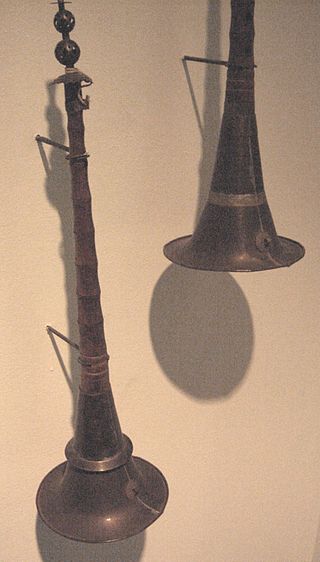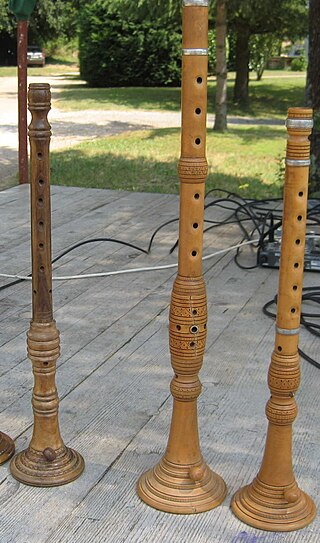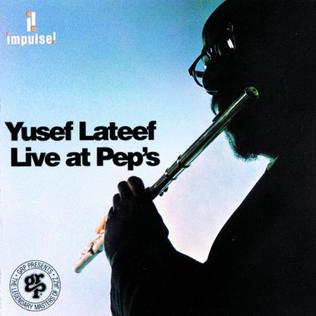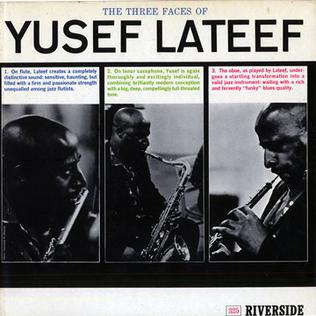
Yusef Abdul Lateef was an American jazz multi-instrumentalist, composer, and prominent figure among the Ahmadiyya Community in the United States.

The shawm is a conical bore, double-reed woodwind instrument made in Europe from the 12th century to the present day. It achieved its peak of popularity during the medieval and Renaissance periods, after which it was gradually eclipsed by the oboe family of descendant instruments in classical music. It is likely to have come to Western Europe from the Eastern Mediterranean around the time of the Crusades. Double-reed instruments similar to the shawm were long present in Southern Europe and the East, for instance the ancient Greek, and later Byzantine aulos, the closely related sorna and zurna, and the Armenian duduk.

In Arabic music, a mizmār is any single or double reed wind instrument. In Egypt, the term mizmar usually refers to the conical shawm that is called zurna in Turkey and Armenia.

The zurna is a double reed wind instrument played in the Central Asia, West Asia, the Caucasus, Southeast Europe and parts of North Africa. It is also used in Sri Lanka. It is usually accompanied by a davul in Armenian, Anatolian and Assyrian folk music.

Suona, also called dida, laba or haidi, is a traditional double-reeded Chinese musical instrument. The Suona's basic design originated in ancient Iran, then called "Sorna". Suona appeared in China around the 3rd century.Popular in parts of northern and southern China, including Shandong, Henan, Hebei, Shanxi, Shaanxi, Gansu, Northeast China, Guangdong, Fujian, and other regions. It had a distinctively loud and high-pitched sound, and was used frequently in Chinese traditional music ensembles, particularly in those that perform outdoors. It was an important instrument in the folk music of northern China, particularly in provinces of Shandong and Henan, where it has long been used for festival and military purposes. It is still being used, in combination with sheng mouth organs, gongs, drums, and sometimes other instruments in weddings and funeral processions. Such wind and percussion ensembles are called chuida or guchui. Stephen Jones has written extensively on its use in ritual music of Shanxi. It was also common in the ritual music of Southeast China. In Chinese culture it was an essential element of ritual music that accompanied Daoist performances of both auspicious and inauspicious rites, i.e., those for both the living and the dead. One of the most famous pieces that uses suona as the leading instrument is called "Bai Niao Chao Feng", or "Hundred Birds Worship the Phoenix". The movie Song of the Phoenix casts the rise and fall of the popularity of suona in modern Chinese musical history.Suona music is filled with tradition and innovation, and is a timeless expression of Chinese folk culture, enriching the daily lives of folk workers. Suona art was approved by the State Council to be included in the first batch of national intangible cultural heritage list on May 20, 2006.

The various nations of the region include the Arabic-speaking countries of the Middle East, the Iranian traditions of Persia, the Jewish music of Israel and the diaspora, Armenian music. Azeri Music, the varied traditions of Cypriot music, the Turkish music of Turkey, traditional Assyrian music, Coptic ritual music in Egypt as well as other genres of Egyptian music in general. It is widely regarded that some Middle-Eastern musical styles have influenced Central Asia, as well as the Balkans and Spain.

The sopile is an ancient traditional woodwind instrument of Croatia, similar to the oboe or shawm. It is used in the regions of Kvarner, Kastav, Vinodol, Island Krk, and Istria. Sopile are always played in pairs so there are great and small or thin and fat sopila. Sopile are musical instruments offering very interesting possibilities with a unique piercing sound. This is replicated in more modern examples of Kvarner music through use of modified double reed clarinet or soprano Dulzaina. Sopile are, by "mih" and "šurle," and today are very popular in the folk traditions of Istria, Kvarner and Island Krk.
The Ukrainian surma is a type of shawm that had widespread use in the armies of the Cossack host. It is thought that the instrument was introduced into Ukraine from the Caucasus or Turkey where the similar instruments exist with related names such as zurna and surnai.

The African Beat is a jazz album by Art Blakey and the Afro-Drum Ensemble recorded for Blue Note on January 24, 1962 and released later that year.

The Cannonball Adderley Sextet in New York is a live album by jazz saxophonist Cannonball Adderley recorded at the Village Vanguard and released on the Riverside label featuring performances by Adderley with Nat Adderley, Yusef Lateef, Joe Zawinul, Sam Jones and Louis Hayes.

Live at Pep's is a 1964 album by the American Jazz tenor saxophonist and flautist Yusef Lateef. Other participating musicians in this album were bassist Ernie Farrow, pianist Mike Nock, drummer James Black and trumpeter Richard Williams. This live album was recorded at Pep's Lounge in Philadelphia, Pennsylvania.

Yusef Lateef's Little Symphony is an album by Yusef Lateef, released through the record label Rhino Atlantic in 1987. The album, which Billboard described as "an atmospheric four-movement classical/jazz composition", was produced by Lateef, recorded, mixed and mastered by Norman Blain, and remastered by Dennis King. Lateef provided all instrumentation that appears on the album. In 1988, Yusef Lateef's Little Symphony earned Lateef the Grammy Award for Best New Age Album despite having no prior association with the genre.

The Three Faces of Yusef Lateef is an album by multi-instrumentalist Yusef Lateef recorded in 1960 and released on the Riverside label.

Cry! – Tender is an album by American multi-instrumentalist Yusef Lateef recorded in 1959 and released on the New Jazz label.

The Gentle Giant is an album by multi-instrumentalist Yusef Lateef recorded in 1970 and 1971 and released on the Atlantic label.

10 Years Hence is a live album by multi-instrumentalist Yusef Lateef recorded in 1974 at Keystone Korner in San Francisco and released on the Atlantic label.

Color Changes is an album by trumpeter Clark Terry featuring performances recorded in the early 60s and originally released on the Candid label.

Yusef Lateef in Nigeria is an album by American multi-instrumentalist and composer Yusef Lateef recorded in 1983 and released on the Landmark label.

















